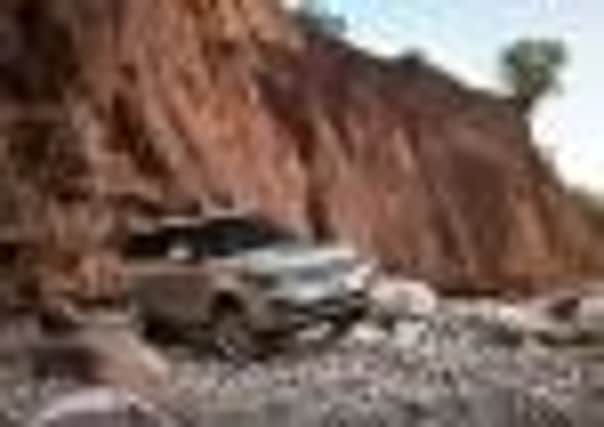Motoring review: Range Rover V6


In the end it had to settle for a quarry in Cornwall because the debut was brought forward six months. It grew into the world’s paramount luxury all-terrain limo. This time it was in North Africa for real, in force, with 200 vehicles and a multi-million pound publicity spend.
This all-new Range Rover is the world’s first all-roader with an aluminium monocoque body structure, 39 per cent lighter than the previous steel body, saving up to 480 kilos – almost half a ton and lighter than a mid-size saloon car shell. It is stiffer and stronger, slightly longer and wider and lower.
Advertisement
Hide AdIt looks “nicer” than before, not as brash “new money”. There is less glitter and bling – with tail lights now plain, almost retro, vertical columns with a lateral spur, in place of the gaudy orbs. The face still has a glittering grille but the air dams are slimmer, the lights more sober, a neat inset Land Rover badge proclaiming its heritage.
They say: Range Rover equals or beats luxury saloons for everyday refinement. We drove it on a variety of roads, beaches, tracks, river beds, up to 9,000 feet in the Atlas above Asni. The Range Rover has been tested at 4,500 metres (14,760 feet) – 1,000m higher than Europe’s highest paved road in Spain’s Sierra Nevada. It has undergone 20,000 “physical” tests in a variety of conditions.
It has been five years in planning, with attention once again given to reliability. Land Rover products have “previous” in this respect and for the Range Rover the electrical systems were much earlier in the programme to eradicate glitches. It was, then, a surprise to hear and feel noise and rattles on the two diesel models we tested – and a faulty electric window switch. Land Rover’s defence is that these were very early pre-production models built months ago and not representative of the on-sale models. A spokeswoman says most testers had praised the vehicle’s quietness. We were obviously in two duffers.
On the motorway, though, it was sublimely serene, hardly any wind noise at 100mph, engine on a relaxed 2,000rpm in eighth gear on the V8 diesel. Given its lower price and strong performance, we preferred the V6 diesel.
Magic carpet ride? The V8 models have anti-roll technology. On normal roads it was disappointing, the suspension was always busy. Perhaps the press briefing had us expecting too much, but we judged the ride as too firm and longed for a comfort setting. The stiffness could be a consequence of the aluminium build: steel has more “give”.
There is the familiar, industry-leading Terrain Response technology which allows the driver or passenger to choose the most suitable drive and ride height system. This time it can be set to auto – which takes away the guesswork for novice off-roaders.
Advertisement
Hide AdThere is some smart interior design – lots of glossy wood, “low carbon” leather from the Bridge of Weir tanners, aluminium detailing, plenty of lidded storage compartments. Yet despite its cabin width, access to the lower door pocket still means squeezing your fist past the seat cushion.
Another ergonomic irritation is mounting the beast. There is a sense of clambering in behind the steering wheel, while at the back you have to avoid the wheel arch incursion into the door aperture.
Advertisement
Hide AdLuggage space is reduced by 69 litres (in allowing storage for a 22-inch spare) and remains just adequate for a car of this size and class. The powered tailgate sections and the power-drop and raise rear seats are muscle-saving options to extend the load deck (not possible with the gent’s club two-seat option because of a fixed bulkhead).
A short drive in an original aluminium-bodied 1971 Range Rover was a reminder of its practicality and its 1,730kg weight. You could crouch-walk between front and rear seats (useful before rear doors were introduced) and the load deck was far bigger than the current Range Rover’s when the seats were up.
It is: The first all-aluminium large 4x4. New kit includes active lean control, parallel parking assistance, adaptive cruise control, rear vehicle warning when driving or reversing.
Motors: Choice of 254bhp 3-litre V6 diesel, 334bhp 4.4 litre V6 diesel and 503bhp supercharged 5-litre litre petrol V8. Torque: respectively 442 lb ft,516 lb ft and 460 lb ft. Gears: eight-speed automatic.
Economy: The V6 diesel gives the lighter car the same performance as the previous 4.4 V8 diesel but is 22 per cent more efficient, rated at 37.7mpg and 196g/km. Figures for the V8 diesel and V8 petrol are 32.5mpg/229g and 20.6mpg/322g.
Speed: The petrol V8 blasts off the 0-60 sprint in 5.1 seconds. V6 diesel is 7.4 seconds, V8 diesel 6.5 seconds.
Advertisement
Hide AdPrices: From £71,295 for the 3.0L TDV6, from £78,095 for the V8 diesel Vogue, Autobiography V8 petrol £98,395.
Verdict: Tour de force of aluminium construction. Full marks for improved economy and the smarter styling. Ride is firmer but handling is surer.